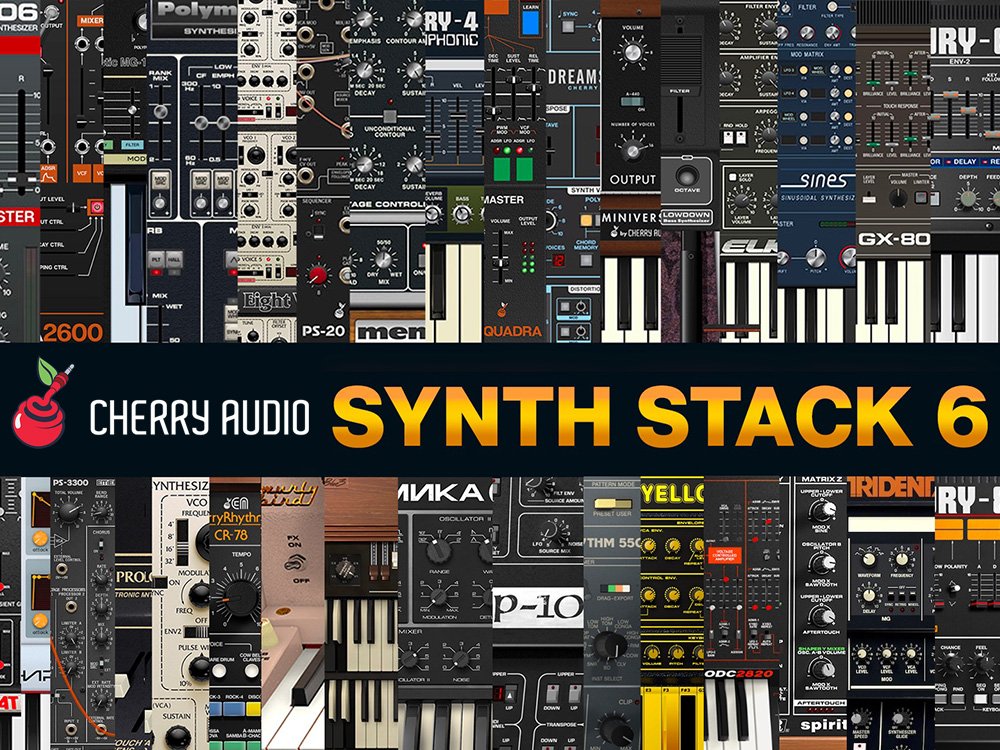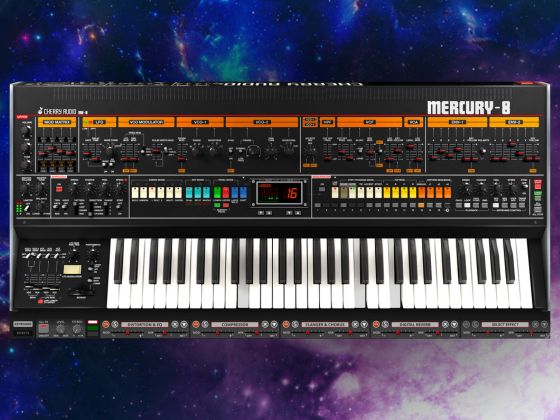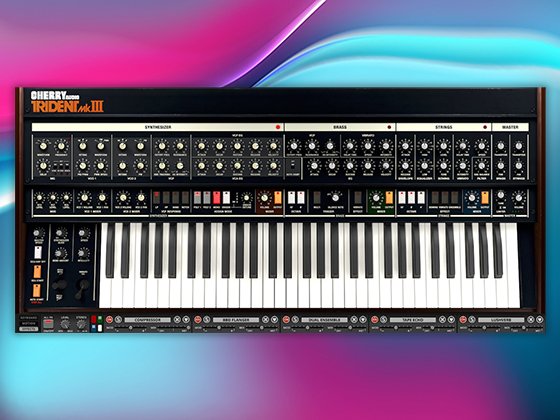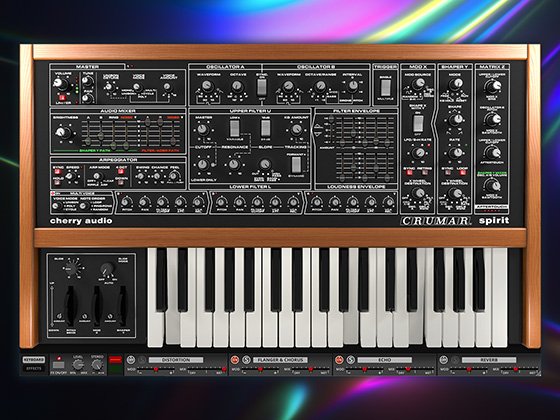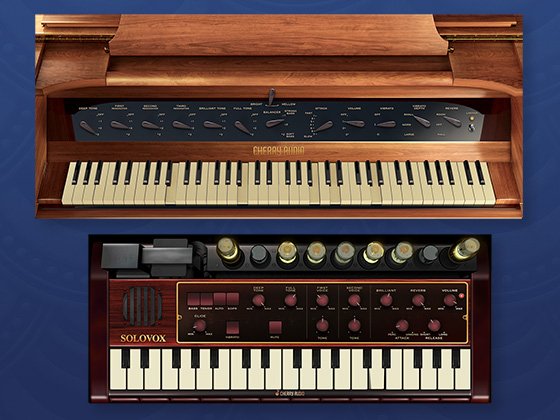Manufacturer: Request For Music
$15.00 $18.00
F-ECHOZ — User Guide
Overview
F-ECHOZ is a character delay with tempo-sync, stereo ping-pong, diffusion, tone shaping, tape/BBD/Digital styles, side-chain ducking, and several pitch-based modes. It’s designed to go from clean studio delays to gritty, animated, “ghostly” textures—fast.
Signal Flow (simplified)
Input → (delay taps) → Wet tone (Bass/Treble) → Mix → Outputs
│
└── Feedback path:
HP → LP → Drive/Clip → Noise → Diffusion → (back into buffer)
Optional modifiers:
- Tempo sync (BPM or CLK input)
- Wow/Flutter/Jitter
- Pitch engine (only active in Pitch/Ghost/RevPitch/RichPitch modes)
Panel I/O
- IN L / IN R — stereo input. If only L is connected, it’s treated as mono.
- DUCK SC — side-chain input. When patched, the wet signal is automatically ducked by this source; the Duck % knob appears (enabled).
- CLK — external clock (quarter-note). Rising edges set the tempo when SYNC is on.
- OUT L / OUT R — stereo outputs.
Core Controls
Time
- Sync (MS/SYNC) — toggles time base.
- MS: use ms directly (1–2000 ms).
- SYNC: tempo-sync to BPM or the CLK jack (if present), then choose a note value via Division (from 1/1 to 1/32 incl. dotted & triplet).
- ms — delay time in milliseconds (enabled only when Sync=MS).
- BPM — internal tempo (enabled only when Sync=SYNC and no external clock is present).
- Division — musical subdivision of a quarter note (enabled in SYNC).
- Mod ms — an extra offset applied to the delay time (adds motion or chorus-like width on small values).
Mix / Feedback / Dynamics
- Mix — 0% = dry only, 100% = wet only.
- FB — feedback amount (internally clamped to ~95% for stability).
- Drive dB — pre-saturation gain feeding the selected style’s saturator (Tape/Diode/Clean).
- Freeze — capture & loop the current delay state. No new input is written while frozen; the buffer keeps circulating through the feedback chain.
- Duck % — wet-signal ducking depth (only enabled when DUCK SC is patched; otherwise inactive).
Stereo & Texture
- PingPong — cross-feedback for true L↔R bouncing. With stereo sources, a mono “seed” is injected on one side so the ping-pong pattern is obvious.
- StOff ms — extra R-channel delay offset for width (disabled when PingPong is ON).
- Jitter — slow random wander of delay time (subtle wow-instability).
- Noise — colored hiss injected in the feedback path. Amount and band are style/mode-dependent (tape = wider hiss, BBD/LoFi = darker/stronger, Digital/HiFi = very subtle).
- Diff % — two-stage allpass diffusion before writing into the buffer; low values = crisp repeats, higher = smeared, reverb-ish tails.
- Smear % — temporal blur: echoes dissolve into each other. At high values they overlap into a cloudy wash.
Filters & Tone
- HP / LP — high-pass & low-pass inside the feedback path (shape the repeating echoes; great for removing mud or taming highs).
- Bass dB / Trebl dB — musical shelves applied to the wet taps (not in the loop). Useful to tilt the overall wet tone without affecting feedback stability.
Modulation
- Wow Hz / Wow ms — slow sine modulation of delay time.
- Flut Hz / Flut ms — faster sine modulation.
- Combine small Wow/Flut with Mod ms for tape-like movement.
Pitch (modes only)
- Pitch st — active in Pitch, RevPitch, RichPitch (and internally in Ghost).
- Live-updates while those modes are selected.
Modes (top button)
- LoFi — narrow band, stronger clipping, darker hiss, noticeable diffusion. Crunchy repeats.
- Tape — gentle low-cut/high roll-off, soft tape clip, mild tilt. Classic warm echoes.
- Chrome Tape — similar to Tape but brighter & tighter band. Slightly cleaner.
- Analog — tape-ish tone with a modest band and tilt; balanced vintage feel.
- BBD — higher low-cut, tougher high roll-off, diode-like clip. Darker, “bucket-brigade” vibe.
- DuckTape — tape-style voicing tuned to sit behind a vocal/instrument when ducked.
- Ghost — tape voicing + pitch “octave-up” taps mixed with normal taps for haunting shimmer-style echoes.
- Phaser DDL — digital voicing with tilt/diffusion for subtle comb-like movement; spacey mod delay.
- Quartz — clean digital with a hint of air; minimal diffusion, tiny noise.
- Digital — very clean, flat band, almost no noise.
- HiFi — digital with slight tilt and extended highs; mix-ready clarity.
- Clarity — flattest band, lowest diffusion, near-silent noise; as transparent as it gets.
- Pitch — clean voicing + Pitch st shifting of repeats (forward grains).
- RevPitch — BBD-ish voicing + pitched reverse grains for whooshy, swelling repeats.
- RichPitch — detuned multi-voice (±7 cents) for thick, chorused repeats. Pitch st sets center pitch.
- BBD Duck — BBD tone pre-tuned for heavy ducking contexts.
How to Hear Each Section Quickly
- PingPong: set PingPong=ON, StOff ms is disabled; use mono input or mute one side. You should hear L→R→L bouncing clearly even with stereo sources.
- Freeze: set Feedback 30–60%, hit notes, then toggle Freeze ON. New input stops feeding the buffer, but the current loop keeps circulating and decaying.
- Noise: pick Tape or LoFi, Feedback ≥40%, turn Noise from 0→0.2. You’ll hear hiss building on repeats.
- Jitter: set Wow/Flut small (Wow 0.2 Hz/2 ms, Flut 5 Hz/1 ms), then raise Jitter 0→0.8. Listen for slight time wobble and stereo width changes.
- HP/LP: with Feedback ~50%, sweep HP upward to thin out the low-end build-up; lower LP to tame fizz.
- Bass/Trebl: adjust overall wet tone without altering feedback loop stability.
- Diff %: 0–10% = crisp; 20–40% = smeared; 50–60% = soft/reverb-like tails.
- Ghost: instant shimmer-like octave layer blended with normal repeats.
- RichPitch: lush modulation; set Pitch st ±3–7 for harmonies.
External Clock
Patch a steady clock to CLK. With SYNC enabled, the module learns the quarter-note period on rising edges. If clock is removed (or silent for >2 s), it falls back to the internal BPM knob.
Presets & State
- All knobs/switches are saved by the host/preset system.
- The mode dropdown is also restored correctly; pitch-based modes automatically re-enable their pitch engines on load.
Examples / Tips
- Vintage Tape Glue: Mode=Tape, Wow 0.3 Hz / 3 ms, Jitter 0.2, Diff 25%, HP 120 Hz, LP 12 kHz. Smooth warming echoes.
- Rhythmic Ping-Pong: Mode=Digital, SYNC 1/8 or 1/16, PingPong ON, Mix 35%, tiny Mod ms (2–3 ms). Perfect for arps/sequences.
- Ambient Shimmer: Mode=Ghost, Feedback 50%, Diff 45%, LP 9–10 kHz, Noise low (0.1). Adds lush octave-up trails.
- Thick Harmonies: Mode=RichPitch, Pitch st +5, Feedback 40%, Drive +3 dB, Diff 35%. Produces chorused harmonized repeats.
- Dark BBD Texture: Mode=BBD, Feedback 60%, Noise 0.2, HP 180 Hz, LP 7 kHz, Diff 30%. Crunchy, vintage delay.
Example Settings per Style (Quick Start)
Tip: Start with Mix 50%, Feedback 35–45%, PingPong ON, Delay ≈ 380–420 ms (or Sync 1/4). Then fine-tune the rest.
LoFi (roughest)
- Delay 420 ms (or 1/4), Feedback 40–55%
- Drive +6 to +9 dB, Noise 35–50%
- HP 250–300 Hz, LP 5–6 kHz
- Bass +2 dB, Treble −2 to −3 dB
- Wow 0.25 Hz / 5–7 ms, Flutter 7 Hz / 3–4 ms
- Jitter 0.5–0.7, Diffusion 35–45%
- Mod ms 4–7 ms
- Why: Narrow band + audible modulation and noise → cassette / cheap BBD vibe.
Tape
- Delay 380 ms, Feedback 40–50%
- Drive +3 to +6 dB, Noise 15–25%
- HP 120–160 Hz, LP 10–12 kHz
- Bass +1 to +2 dB, Treble −1 to −2 dB
- Wow 0.3 Hz / 3–5 ms, Flutter 6 Hz / 2–3 ms
- Jitter 0.2–0.4, Diffusion 30–40%
- Mod ms 2–4 ms
- Why: Gentle tilt, soft clipping, subtle W&F → classic tape repeats.
Chrome Tape (bright tape)
- LP 12–14 kHz, HP 100–140 Hz
- Wow 0.25 Hz / 2–4 ms, Flutter 5–6 Hz / 2–3 ms
- Treble −0 to −1 dB
- Noise 10–20%, Diffusion 20–30%
- Why: Slightly brighter “chrome” character.
Analog
- HP 100 Hz, LP 9–11 kHz
- Drive +2–4 dB, Noise 10–15%
- Wow 0.25 Hz / 2–4 ms, Flutter 5–6 Hz / 2–3 ms
- Jitter 0.2–0.3, Diffusion 25–35%
- Why: Cleaner than Tape, still analog-like contours.
BBD (bucket-brigade)
- HP 150–180 Hz, LP 6–8 kHz
- Drive +4–7 dB, Noise 25–35%
- Wow 0.2 Hz / 2–3 ms, Flutter 7–9 Hz / 2–3 ms
- Jitter 0.3–0.5 (clock smear), Diffusion 25–35%
- Why: Darker, gritty with audible modulation.
DuckTape
- Duck Sidechain input from kick/vocal, Duck % 30–50%
- Otherwise same as Tape, but Feedback can be pushed higher (50–65%)
- Why: Echoes sink under the lead → headroom preserved.
Ghost
- Pitch knob active, try +12 semitones
- Diffusion 45–55%, LP 8–10 kHz, Noise 10–20%
- Why: Shimmer-like octave layer, ethereal with PingPong ON.
Phaser DDL
- HP 80–120 Hz, LP 14–16 kHz
- Diffusion 30–45% (phasey smear)
- Mod ms 2–4 ms, Wow 0.15–0.25 Hz
- Why: Not a real phaser but diffusion + comb modulation gives that effect.
Quartz
- HP 50–70 Hz, LP 18–19 kHz
- Drive 0 to +2 dB, Noise 5–10%
- Diffusion 5–10%, Wow 0.1–0.15 Hz
- Why: Very clear, minimal movement.
Digital
- HP 40–60 Hz, LP 17–19 kHz
- Drive −2–+2 dB, Noise 0–10%
- Diffusion 5–10%, Wow 0.1 Hz, Flutter 3 Hz
- Why: Reference-clean; good for tight, tempo-synced delays.
HiFi
- HP 40–60 Hz, LP 17 kHz
- Drive 0–+2 dB, Noise 0–8%
- Diffusion 15–20%, Wow 0.15–0.2 Hz
- Why: Musical glue, still hi-fi.
Clarity
- HP 20–40 Hz, LP 19–20 kHz
- Drive −2–0 dB, Noise 0–5%
- Diffusion 0–5%
- Why: Maximum transparency, studio-grade digital feel.
Pitch
- Pitch ±3–7 st, Diffusion 35–50%
- HP 60–80 Hz, LP 14–16 kHz
- Why: Pitch-shifter inside the delay line.
RevPitch
- Pitch ±3–7 st, Delay 500–650 ms
- LP 6–8 kHz, Diffusion 50–60%
- Why: Reverse grains + pitch → dreamy tails.
RichPitch
- Pitch 0 (mode adds subtle chorus internally)
- Diffusion 50–60%, LP 14–16 kHz
- Why: Layered pitch voices, wide stereo shimmer.
BBD Duck
- Duck SC patch, Duck % 35–55%
- HP 140–160 Hz, LP 7–9 kHz, Noise 20–30%
- Why: Dark/compact with automatic space for the dry.
Stereo & Sync Tips
- PingPong ON for call/response. With stereo input the ping-pong path forces a mono seed so it’s always audible.
- Stereo Offset 6–12 ms (only when PingPong OFF) → width without phasing.
- Sync: 1/8 and 1/4 are “safe”. For dotted/triplets use 1/8. and 1/8T.
Artist Presets
1. Slapback Rockabilly
- Mode Digital
- Delay 90–110 ms (no sync)
- Feedback 15–20%
- Mix 25–35%
- Drive +3 dB, Noise off
- Result: Classic Elvis / Sun slapback.
2. Ambient Pad Cloud
- Mode RevPitch
- Delay 600 ms (1/2 note)
- Feedback 65–70%
- Diffusion 55–65%
- Pitch +7 st, Noise 10%
- Result: Huge reversed shimmer, pad-like trails.
3. Dub Echo (classic reggae)
- Mode BBD
- Delay 420 ms (1/4 note)
- Feedback 80–90% (careful!)
- Drive +6 dB, Noise 30%
- Wow 0.3 Hz / 4 ms, Flutter 7 Hz / 3 ms
- Result: Self-oscillating, dirty dub echoes.
4. Vocal Throw (pop/EDM)
- Mode DuckTape
- Delay 500 ms (1/2 note)
- Feedback 45–55%
- Mix 40–50%
- Duck SC from lead vocal, Duck % 40%
- Result: Big vocal echoes that clear space under the dry vocal.
